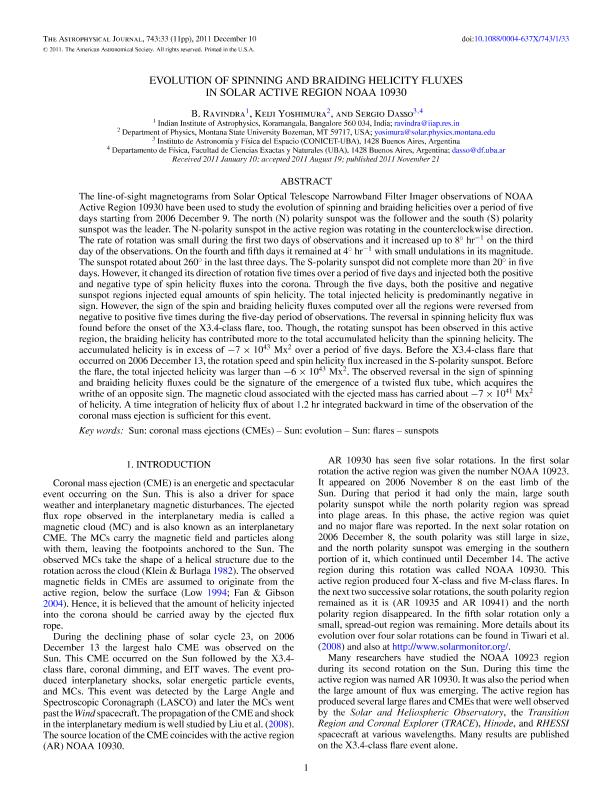Artículo
Evolution of spinning and braiding helicity fluxes in solar active region NOAA 10930
Fecha de publicación:
12/2011
Editorial:
IOP Publishing
Revista:
Astrophysical Journal
ISSN:
0004-637X
Idioma:
Inglés
Tipo de recurso:
Artículo publicado
Clasificación temática:
Resumen
The line-of-sight magnetograms from Solar Optical Telescope Narrowband Filter Imager observations of NOAA Active Region 10930 have been used to study the evolution of spinning and braiding helicities over a period of five days starting from 2006 December 9. The north (N) polarity sunspot was the follower and the south (S) polarity sunspot was the leader. The N-polarity sunspot in the active region was rotating in the counterclockwise direction. The rate of rotation was small during the first two days of observations and it increased up to 8°hr-1 on the third day of the observations. On the fourth and fifth days it remained at 4°hr-1 with small undulations in its magnitude. The sunspot rotated about 260° in the last three days. The S-polarity sunspot did not complete more than 20° in five days. However, it changed its direction of rotation five times over a period of five days and injected both the positive and negative type of spin helicity fluxes into the corona. Through the five days, both the positive and negative sunspot regions injected equal amounts of spin helicity. The total injected helicity is predominantly negative in sign. However, the sign of the spin and braiding helicity fluxes computed over all the regions were reversed from negative to positive five times during the five-day period of observations. The reversal in spinning helicity flux was found before the onset of the X3.4-class flare, too. Though, the rotating sunspot has been observed in this active region, the braiding helicity has contributed more to the total accumulated helicity than the spinning helicity. The accumulated helicity is in excess of -7 × 1043Mx2 over a period of five days. Before the X3.4-class flare that occurred on 2006 December 13, the rotation speed and spin helicity flux increased in the S-polarity sunspot. Before the flare, the total injected helicity was larger than -6 × 1043Mx2. The observed reversal in the sign of spinning and braiding helicity fluxes could be the signature of the emergence of a twisted flux tube, which acquires the writhe of an opposite sign. The magnetic cloud associated with the ejected mass has carried about -7 × 1041Mx2 of helicity. A time integration of helicity flux of about 1.2hr integrated backward in time of the observation of the coronal mass ejection is sufficient for this event. © 2011. The American Astronomical Society. All rights reserved.
Palabras clave:
Sun: Coronal Mass Ejections (Cmes)
,
Sun: Evolution
,
Sun: Flares
,
Sunspots
Archivos asociados
Licencia
Identificadores
Colecciones
Articulos(IAFE)
Articulos de INST.DE ASTRONOMIA Y FISICA DEL ESPACIO(I)
Articulos de INST.DE ASTRONOMIA Y FISICA DEL ESPACIO(I)
Citación
Ravindra, B.; Yoshimura, Keiji; Dasso, Sergio Ricardo; Evolution of spinning and braiding helicity fluxes in solar active region NOAA 10930; IOP Publishing; Astrophysical Journal; 743; 1; 12-2011; 33-44
Compartir
Altmétricas




